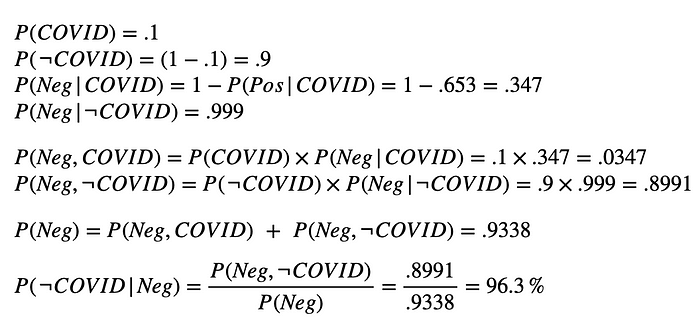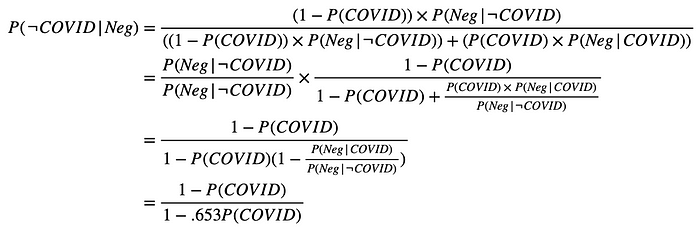Can you trust a COVID-19 negative test result?
Omicron is spiking throughout US and people are rushing to get tested before seeing friends and family. But does a negative test result really mean that you don’t have COVID?
You can look up statistics about a test to get an idea of how effective it is. For example, in symptomatic individuals the Rapid Antigen Test has a sensitivity of 65.3% and a specificity of 99.9% [Source].
This means that an individual with COVID has a 65.3% chance of testing positive and an individual without COVID has a 99.9% chance of testing negative.
But is the reverse true — if you test negative, does that mean you have a 99.9% chance of not having COVID? That isn’t quite right! It might be surprising, but the correctness of a negative result relies on the prevalence of COVID in the population. As more people around you have COVID, a negative test result is less reliable.
Let’s investigate.

As we know, test results can be inaccurate. In the chart above, we can see that negative test results can be given to people with and without COVID. As the population with COVID (red bubble) gets bigger, there is a higher chance that a negative test result belongs to that group.
So how much trust can you place in a negative test result? Put another way, what are the odds you don’t have COVID if you get a negative result?
We can work through this intuitively. Let’s start with the following assumptions:
- Total Population is 1M
- 10% of the Population has COVID
We can use these values along with the sensitivity and specificity percentages above to fill out the previous diagram.

The probability of not having COVID when getting a negative test result are:

From these numbers it seems like a negative test result is still pretty reliable! What we did above was essentially Bayes Theorem. It can be re-written more mathematically like so:

In the equations above, we assume that the probability of COVID in the population - P(COVID) - is 0.1, or 10 percent. To get a better understanding of how COVID prevalence in the population affect test reliability, we can re-write the equation above as a function of P(COVID).

We can plot this equation to visually see that negative test reliability goes down as COVID prevalence increases.

Using the rapid antigen test, it’ll take a COVID prevalence of around 75% before a negative result is as good as guessing. However, we’re not quite close to that. At the time of writing this article, it looks like the COVID prevalence is around 20%. This means the probability of not having COVID if you test negative is greater than 90%.
That’s still pretty good! Stay safe everyone.
